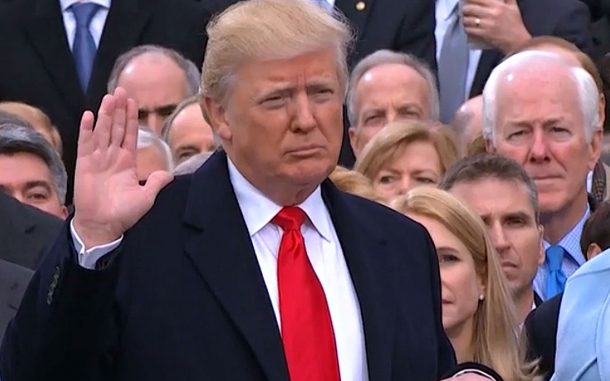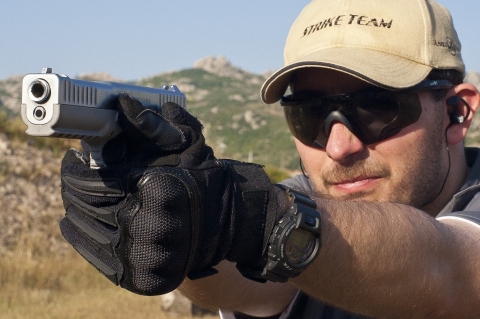Donald Trump sworn in, what now for the gun industry?
SHOT Show 2017 - Donald J. Trump was sworn in as the 45th President of the United States the last day of the SHOT Show; what's in store for the U.S. civilian firearms industry, and what for the European industry?
The 2017 edition of the SHOT Show – the 39th overall – ended at the Sands Expo & Convention Center in Las Vegas (Nevada) last January 20th in an overall positive climate of great expectations for the civilian sporting, hunting, and defensive firearms market.
With and attendance totaling nearly 65.000 from 100 Countries, surpassing last year's turnout to make it the second most attended in the SHOT Show history, the 2017 edition also counted more than 1.600 exhibiting companies, including 338 showing more than 500 new products.
At one of the show's biggest events – the NSSF State of the Industry Dinner on the first day – NSSF President and CEO Steve Sanetti, in a speech titled "A New Hope," listed a series of priorities that the industry will focus on to help protect its future and that of its customers:
« Our overriding hope is that when it comes to helping stop the misuse of firearms by criminals, and preventing access to them by legally prohibited felons, the violently mentally ill, and the drug gangs who terrorize disarmed inhabitants of our cities, the American public will realize we are all on the same side.»

Donald Trump was sworn in as the 45th President of the United States on January 20
And among the staunchest defenders of the right of the American people to keep and bear arms is Donald John Trump, who on January 20th – the final day of the 2017 SHOT Show – was sworn in as the 45th President of the United States following his surprise victory in the November 2016 presidential elections.
The SHOT Show literally froze for an hour during the inauguration ceremony, which was broadcast on the screens that were installed on the halls and some of the most important booths at the Sands Expo & Convention Center. Aside from the typical American sentiment of unity that accompanies all public events related to the presidency, Trump's inauguration got a mixed reception among the attendees, with some warmly clapping and cheering at the images of the ceremony, others being much less enthusiastic.
Just like American society at large, the American gun industry and gun owners community is split among those who supported and voted for Donald Trump wholeheartedly and those who voted for him in order to prevent the White House to pass from the hands of anti-gun Barack Obama to those of an even more anti-gun Hillary Clinton.
But while the next four years will see the Second Amendment of the Constitution of the United States free from the threat of restrictions against law-abiding citizens, prospectives may not be equally good for all gun manufacturers.
A wide screen in the Smith & Wesson booth: SHOT Show stopped for a while during the inauguration ceremony of Donald Trump
Right after taking his oath of office and during his inauguration speech, Donald Trump referenced protectionism as one of the key points of his economic policy. American industries will be encouraged to manufacture directly and entirely in the United States rather than to establish manufacturing facilities abroad, and imported goods are likely to be hit by heavy excise duties.
Bilateral trade agreements and deals will be established between the United States and individual Countries, ignoring or bypassing entities such as the European Union – most probably in an attempt to weaken them. And the U.S. will exit trade agreements that are detrimental to the U.S. economy, such as the Trans-Pacific Partnership (TPP).
It's thus clear that the American gun industry may benefit from Trump's economic choices, along with those foreign gun companies that have already long established manufacturing facilities in the United States. But will that be enough? Maybe, but again maybe not; for until the true extent of Trump's idea of protectionism is clear, the bulk of the European gun industry will remain uncertain on whether or not they will be able to continue their activities on the U.S. market.
Groups of people standing at SHOT Show, during the inaugural ceremony of Donald Trump
And that's when all chicken will come home to roost. A deep divide will emerge between the biggest players who had the money and the capabilities to establish manufacturing facilities in the U.S. and the small and medium European gunmakers that can not and may never be able to; the compression of the European gun market, caused by restrictive laws which the European gun industry never opposed – as the American market was considered more appealing and lucrative – will put many companies against the wall; and so will be the deficiencies of many European gun manufacturers in fields such as innovation and public communication, which have long been overlooked in the foolish, delusional idea that "our classic products just sell themselves and always will".
And the risk is to face the same kind of situation that caused Beretta to loose the U.S. Army XM17 MHS service pistol trial to SIG Sauer, a company that has long moved the vast majority of its production to the United States and whose approach towards marketing communication has always been much different.
Paradoxally, the election of a pro-gun President may turn out to be a disaster for gun manufacturers on this side of the Atlantic Ocean. And then, all the calls to the European gun industry to change their course in the past twenty years or even more – all fallen on deaf ears – will come back to haunt those who will have to look back and admit that so many irreparable mistakes were made.



